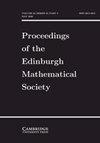Unit sphere fibrations in Euclidean space
IF 0.7
3区 数学
Q2 MATHEMATICS
Proceedings of the Edinburgh Mathematical Society
Pub Date : 2024-03-07
DOI:10.1017/s0013091524000038
引用次数: 0
Abstract
We show that if an open set in  $\mathbb{R}^d$ can be fibered by unit n-spheres, then
$\mathbb{R}^d$ can be fibered by unit n-spheres, then  $d \geq 2n+1$, and if
$d \geq 2n+1$, and if  $d = 2n+1$, then the spheres must be pairwise linked, and
$d = 2n+1$, then the spheres must be pairwise linked, and  $n \in \left\{0, 1, 3, 7 \right\}$. For these values of n, we construct unit n-sphere fibrations in
$n \in \left\{0, 1, 3, 7 \right\}$. For these values of n, we construct unit n-sphere fibrations in  $\mathbb{R}^{2n+1}$.
$\mathbb{R}^{2n+1}$.
欧几里得空间中的单位球纤维
我们证明,如果$\mathbb{R}^d$中的一个开集可以被单位n球纤维化,那么$d \geq 2n+1$,如果$d = 2n+1$,那么球体必须是成对链接的,并且$n \in \left\{0,1,3,7 \right\}$。对于这些 n 值,我们在 $\mathbb{R}^{2n+1}$ 中构造单位 n 球纤维。
本文章由计算机程序翻译,如有差异,请以英文原文为准。
求助全文
约1分钟内获得全文
求助全文
来源期刊
CiteScore
1.10
自引率
0.00%
发文量
49
审稿时长
6 months
期刊介绍:
The Edinburgh Mathematical Society was founded in 1883 and over the years, has evolved into the principal society for the promotion of mathematics research in Scotland. The Society has published its Proceedings since 1884. This journal contains research papers on topics in a broad range of pure and applied mathematics, together with a number of topical book reviews.

 求助内容:
求助内容: 应助结果提醒方式:
应助结果提醒方式:


